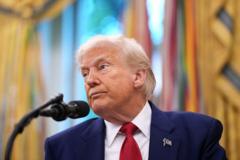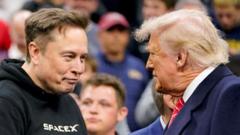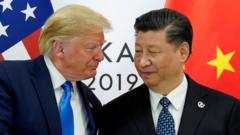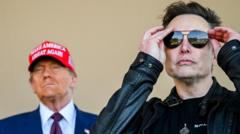**Prime Minister Mark Carney's recent challenges highlight vulnerabilities in his campaign amidst fluctuating U.S. trade relations.**
**Trump’s Trade Turmoil Hits Canadian Politics Hard**

**Trump’s Trade Turmoil Hits Canadian Politics Hard**
**The effects of U.S. tariffs on Canada’s election landscape create complications for leaders.**
In a political whirlwind, Prime Minister Mark Carney faced significant challenges as campaign efforts were hampered by ongoing tensions with President Trump over trade. Initially, Carney seemed to have navigated through a week without disruption, but Trump’s trade policies reemerged as a dominant issue, forcing the Prime Minister back to Ottawa for urgent cabinet discussions on U.S.-Canada relations.
The recent week saw Canada retaliate with a steep 25 percent duty on American cars and trucks, an action precipitated by Trump's imposition of similar tariffs on Canadian goods. Although there were brief suggestions from Trump’s administration to escalate tariffs further, the president pulled back on imposing his most extreme global tariffs, which had caused upheaval in financial markets. Nonetheless, the stringent tariffs on Canadian automobiles, steel, and aluminum remain in place.
Under the current trade agreements, Canada still faces a 10 percent tariff on oil and gas products, while China, the U.S.'s third-largest trading partner, encounters a staggering 145 percent minimum tariff. The ongoing trade saga complicates the political arena for Carney and his opponents, as the focus now shifts between domestic issues like the economy and public safety, yet the backdrop of U.S. trade policies continues to loom significantly during the election cycle.
The recent week saw Canada retaliate with a steep 25 percent duty on American cars and trucks, an action precipitated by Trump's imposition of similar tariffs on Canadian goods. Although there were brief suggestions from Trump’s administration to escalate tariffs further, the president pulled back on imposing his most extreme global tariffs, which had caused upheaval in financial markets. Nonetheless, the stringent tariffs on Canadian automobiles, steel, and aluminum remain in place.
Under the current trade agreements, Canada still faces a 10 percent tariff on oil and gas products, while China, the U.S.'s third-largest trading partner, encounters a staggering 145 percent minimum tariff. The ongoing trade saga complicates the political arena for Carney and his opponents, as the focus now shifts between domestic issues like the economy and public safety, yet the backdrop of U.S. trade policies continues to loom significantly during the election cycle.



















